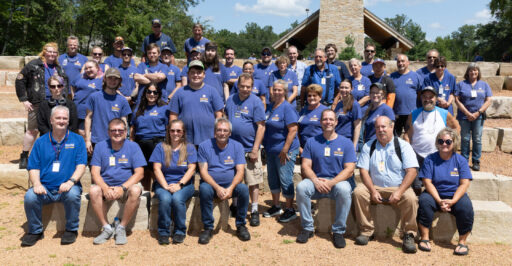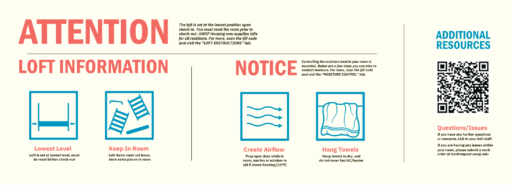SAFE AND SOUND
We have what you need to make your on-campus living experience safe, comfortable, and successful! Whether you’re looking for maintenance support, guidance on cleaning your space, or information about our furniture or housing processes, we’ve got you covered. Explore the tools and services available to help you navigate campus life and create a home away from home.
SAFETY FIRST
If you see something that needs to be fixed or have a safety concern, our maintenance team is just a work order away. Reporting issues early helps us address your concerns quickly, ensuring your space stays in great shape.

Keeping your room in a sanitary condition is also important, and we make it easy by offering free cleaning supplies for you to check out. Whether you need a vacuum or other standard tools, we’ve got you covered!
Remember, residents will not be charged for maintenance services unless our staff determines the issue is due to vandalism or neglect. Take advantage of our resources to keep your living space in top condition!
KEEP IT CLEAN
We expect students to regularly clean their rooms. This includes wiping down furniture, vacuuming, doing laundry, washing dishes, wiping up any condensation by the window, and emptying your trash and recycling. Routine cleaning improves your indoor air quality.
Available to check out at the building’s front desk, for free:
- Cleaning kits (some variation by building)
- HEPA-filter vacuums
- Garbage bags
- Portable dehumidifiers, limited supply
Available elsewhere, for free:
- Washers and dryers
- Kitchen sinks
- Recycling chutes
- Trash dumpsters
- Replacement damp bags (via work order)
- Portable air scrubbers (via work order), limited supply
If you see or suspect mold or mildew, immediately complete a work order.
If you have any questions or concerns, please contact us at housing@uwsp.edu
WHAT TO KNOW
- Molds produce allergens, but like any other allergen, exposed individuals will respond differently.
- If you are having symptoms and think mold allergens may be causing them, schedule an appointment with Student Health Service. Many illnesses share similar symptoms, so a proper examination is key to identifying the cause and treatment.
- The EPA reports that “there is no practical way to eliminate all mold and mold spores in the indoor environment; the way to control indoor mold growth is to control moisture”.
- UW-Stevens Point has a plan in place to identify and treat areas of potential mold growth.
LEARN MORE FROM THE EPA
Molds are part of the natural environment and can be found everywhere, indoors and outdoors. Mold is not usually a problem unless it begins growing indoors.
The best way to control mold growth is to control moisture. The EPA provides guidance about mold and moisture for homes, schools, multifamily and commercial buildings.
MOISTURE CONTROL TIPS
- Ventilation: Frequently open windows/doors to mix outside and room air.
- Room Occupancy: Use common or outdoor spaces for gatherings to improve air quality.
- Cleaning: Dust, vacuum, and clean regularly to reduce allergens. Wipe up any condensation near windows or elsewhere.
- Fabric Care: Wash and store bedding, clothes, and towels to prevent mold and dust mite accumulation.
- Waste Removal: Empty trash and recycling promptly to avoid pests and growth.
- Limit Moisture: Avoid items like fish tanks, plants, and humidifiers that raise humidity. Fully dry your laundry and hang up damp towels.
- Window Treatments: Adjust curtains/blinds seasonally to manage drafts and warmth.
- Air Circulation: Use a fan to improve air movement. Keep furniture slightly away from the walls whenever possible. Keep the top of the heating and cooling vent unit clear and maintain at least 12 inches of space in front of the unit.
- Furnishings: Choose dust-free, non-absorbent materials and space furniture for airflow.
- Report Issues: Routinely check near the windows and the walls behind furniture for concerns and submit a work order or notify building staff.
 For your convenience, on the inside of every traditional residence hall room door is a sticker with information about lofts, tips for controlling moisture levels, a QR code linking to our Additional Resources webpage, and a link to the work order system.
For your convenience, on the inside of every traditional residence hall room door is a sticker with information about lofts, tips for controlling moisture levels, a QR code linking to our Additional Resources webpage, and a link to the work order system.
BASIC LAUNDRY INSTRUCTIONS:
- Sort: Separate colors, whites, and delicate fabrics to prevent color bleeding and damage.
- Load: Fill the machines about 2⁄3 full to allow enough space for proper agitating and tumbling.
- Detergent: Add the right amount of detergent (check the label) for a fresh and clean result.
- Settings: Select the appropriate cycle and temperature to suit your laundry needs. Cool water works well with most modern detergents.
- Dry: When dry, remove your laundry promptly from the machine to prevent wrinkles and make room for the next student’s clothes.
LAUNDRY TIPS:
- Set a reminder to rotate/retrieve your laundry
- Check and clean the lint traps to speed up dry time and prevent fires
- Do not overload washers or dryers
- Dry clothing completely before bringing back to your room
- If the washer or dryer is not working properly, submit a work order! Your resident assistant or the student employee at the front desk can help.
Yes, and in every other building you normally occupy, including your home, and outside, all the time. Mold spores are always present in outside air and indoor air, except in sterile environments such as certain laboratories and medical spaces.
When mold is detected, UW-Stevens Point follows the mold management plan to remediate the problem.
Maybe. Mold spores are always floating in the air and will grow when they have the right amount of moisture. Condensation around windows or on pipe insulation, for example, can allow certain types of fungus to grow. What you see could also just be dirt, dust, and particulates that settle and collect on those surfaces.
Almost certainly not. We all breathe and touch many types of microscopic mold spores every day and the great majority of people have no reactions. Some people who have chronic respiratory issues, such as asthma, who are already sick, or who are immuno-compromised, may have reactions to certain types of mold.
If a student thinks there is a mold issue in their room, they should immediately submit a work order. If the student needs assistance with the work order, they can get assistance at the front desk or from other hall staff.
- Staff members who are trained to identify mold assess the area in question.
- If mold is found, our mold protocol is activated. All practices in the plan are in line with guidelines provided by the U.S. Environmental Protection Agency (EPA).
- UW–Stevens Point has multiple methods of responding to reports of mold growth, in accordance with the mold protocol:
- Affected areas are cleaned and treated with products that have mold inhibitors.
- When mold growth requires complex or sizable remediation, UW-Stevens Point works with an approved third-party abatement contractor to address the issue.
Student Health Service frequently sees patients concerned about common seasonal illnesses such as the flu, “stomach bugs” and respiratory illnesses that might affect their ability to keep up with academic commitments and social activities. Student Health Service tracks these illnesses closely and looks for any meaningful trends.
One of the challenges of being a student on a college campus is exposure to illnesses among friends, classmates and hallmates. Communal living environments – as well as busy, active lifestyles – contribute to college students’ risk of contracting common contagious illnesses.
Yes. Staff at UW–Stevens Point have been in contact with several universities and learned that our procedures are similar to theirs.
Mold produces allergens, but like any other allergen, exposed individuals will respond differently. Some may have no reaction, some may experience hay fever-type symptoms, and others may experience more significant symptoms. It is important to keep in mind that many students new to Wisconsin will experience seasonal allergy symptoms, even without a prior history of this condition. Symptoms typically will arise during the first or second year at UW–Stevens Point. Having never experienced problems with seasonal allergies, many students may attribute these symptoms to a sinus infection or become concerned that there is mold in their residence hall.
Mold is not regulated by the Occupational Safety and Health Administration (OSHA) or the Environmental Protection Agency (EPA). Mold is a natural byproduct of various conditions, often occurring in warm and moist environments where there is abundant vegetation such as trees, landscaping plants, and ground coverings. According to the EPA, mold cannot be totally eliminated in the environment unless extreme measures are taken constantly, as would be the case in a “clean room” laboratory.
Indoor sources for mold have been linked to indoor moisture and lack of air movement. In the past, leaking pipes, standing water, damp clothing or towels, and condensation in the area have been contributing factors. Furniture very close to walls or blocking heating/cooling units have also led to increased moisture due to lack of air flow. UW-Stevents Point is equally concerned about finding the source of the mold and cleaning it. If mold can be prevented by taking certain steps, we will do so.
Recommendations:
- Keeping your space open, clean and dry will prevent mold growth and will reduce the amount of dust, dust mites, particulates and other allergens in the air.
- Operate your heating/cooling units within proper parameters. Do not leave windows open during cold weather while running the heat, not during hot weather while running the air conditioning.
- Never leave damp material like clothes, towels or shoes on the floor or any other surface, they give an ideal environment for mold.
- Don’t overcrowd your space with furniture and other items. Keep all furniture and other materials away from heating/cooling units to allow proper airflow and to prevent creating dark, cramped spaces where mold can flourish.
- Immediately report any leak or sign of water intrusion or suspected mold that you notice.
UNIVERSITY-PROVIDED FURNITURE
CUSTOMIZE YOUR SPACE
Beds in all residence halls are now self-lofting.
With a couple of relatively strong (and coordinated) folks, the metal loft frames height can be adjusted every 2 ⅝” up to 60″ high, with an overall bed size of 38″W x 86″L.
Pack your TWIN XL bedding!
LEARN MORE
OTHER SUGGESTIONS
Miscellaneous resources to help with move in, what to bring, and how to set up your roommate group.
The Official Storage and Shipping Partner of UW-Stevens Point
STORAGE SQUAD
Here’s how it works:
1. Reserve Your Spot: Book online with Storage Squad.
2. Get FREE Supplies: Pick up boxes and tape on campus.
3. Pack and Label: Organize your belongings.
4. We Handle the Rest: Storage Squad picks up, stores securely, and delivers right to your room.
5. Shipping When Needed: Ship domestically via UPS Ground when and where you request.
FORMS AND ACCOMMODATIONS
Exceptions and Accommodations
Medical, religious, and identity-based accommodations. Exceptions to requirements. Family Educational Rights and Privacy Act (FERPA) release form.
CONTACT US
Housing Office
1108 Fremont Street Suite 102
Stevens Point, WI 54481-3897
Phone: 715-346-3511
Direct comments to housing@uwsp.edu